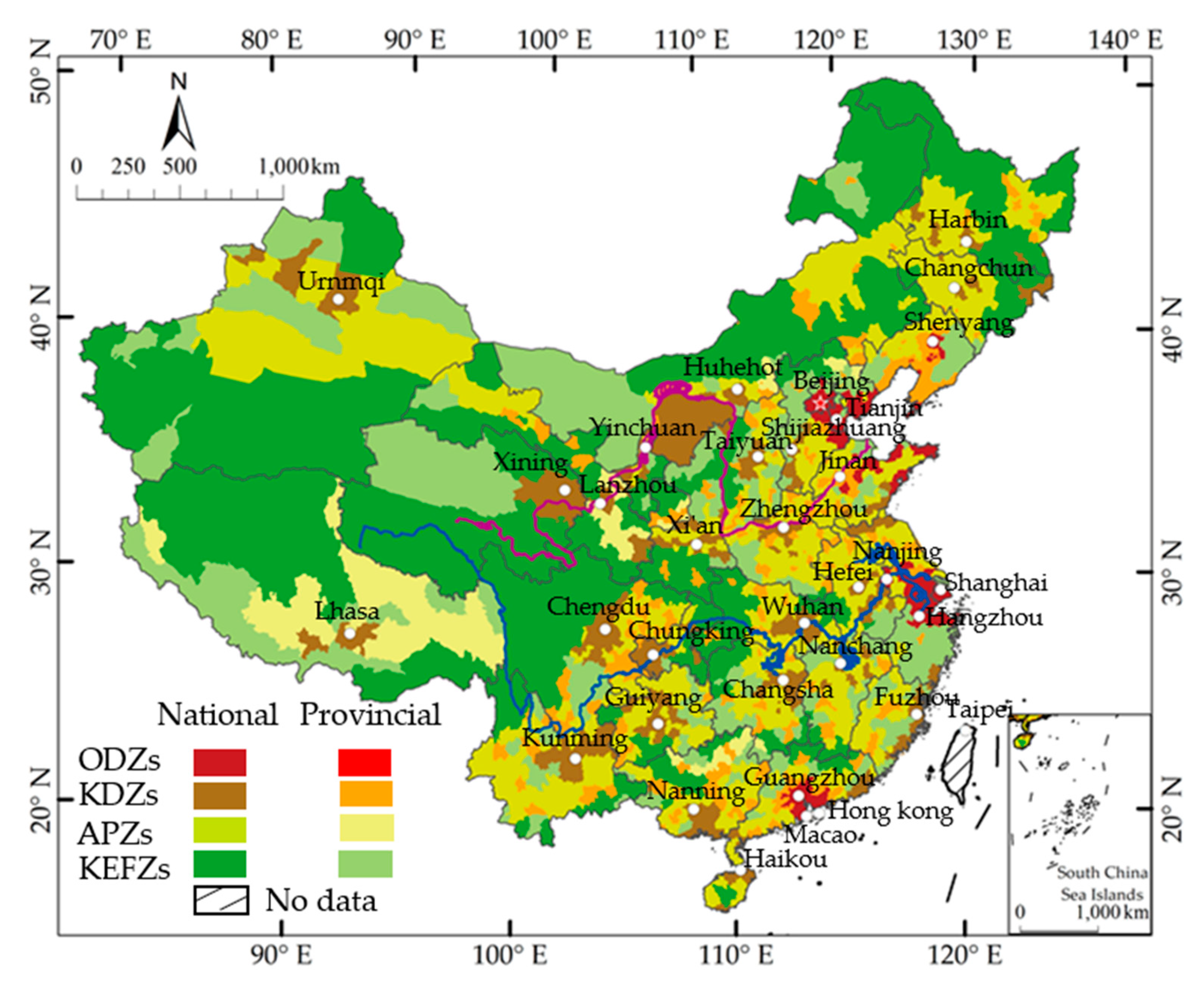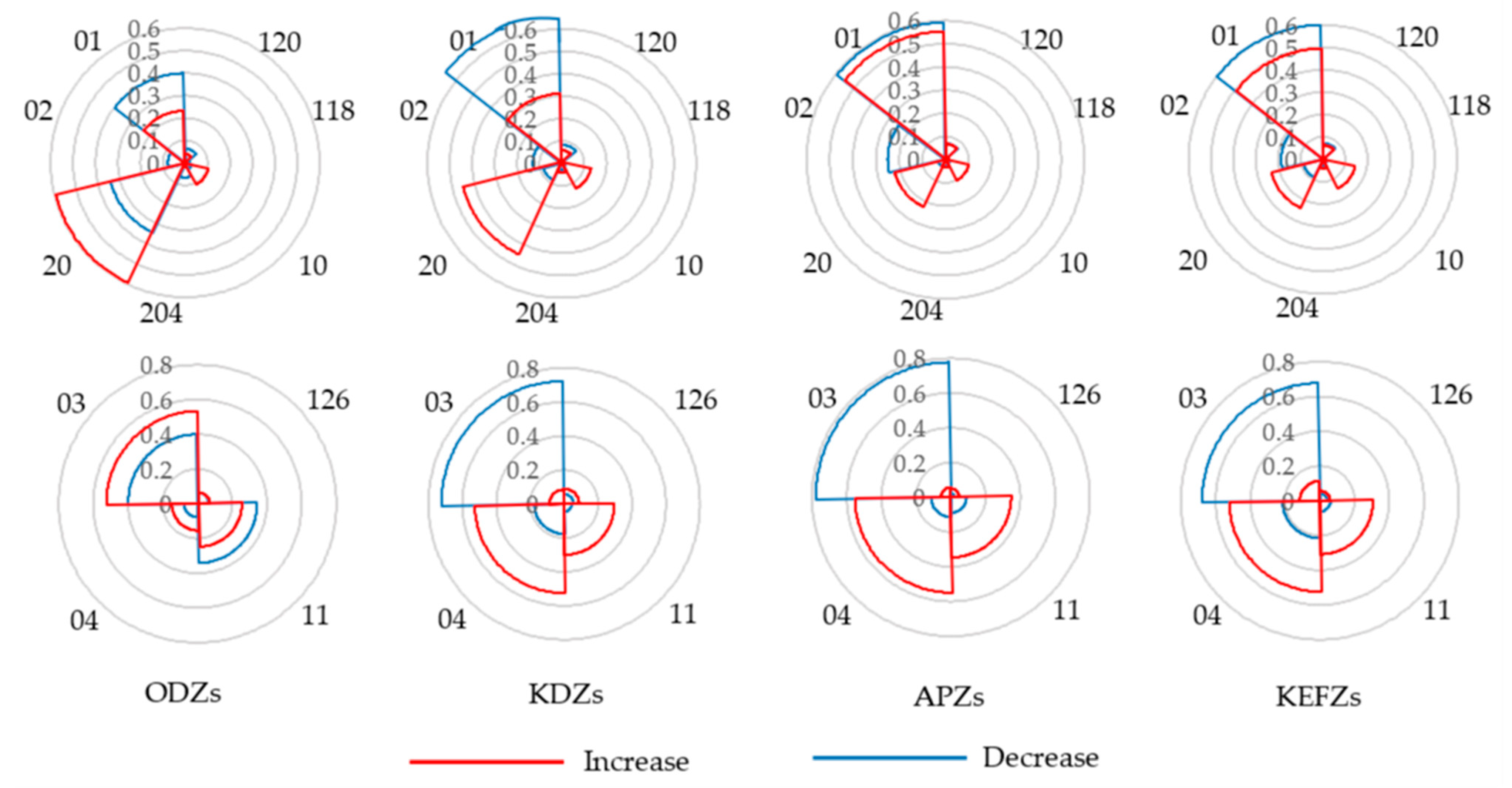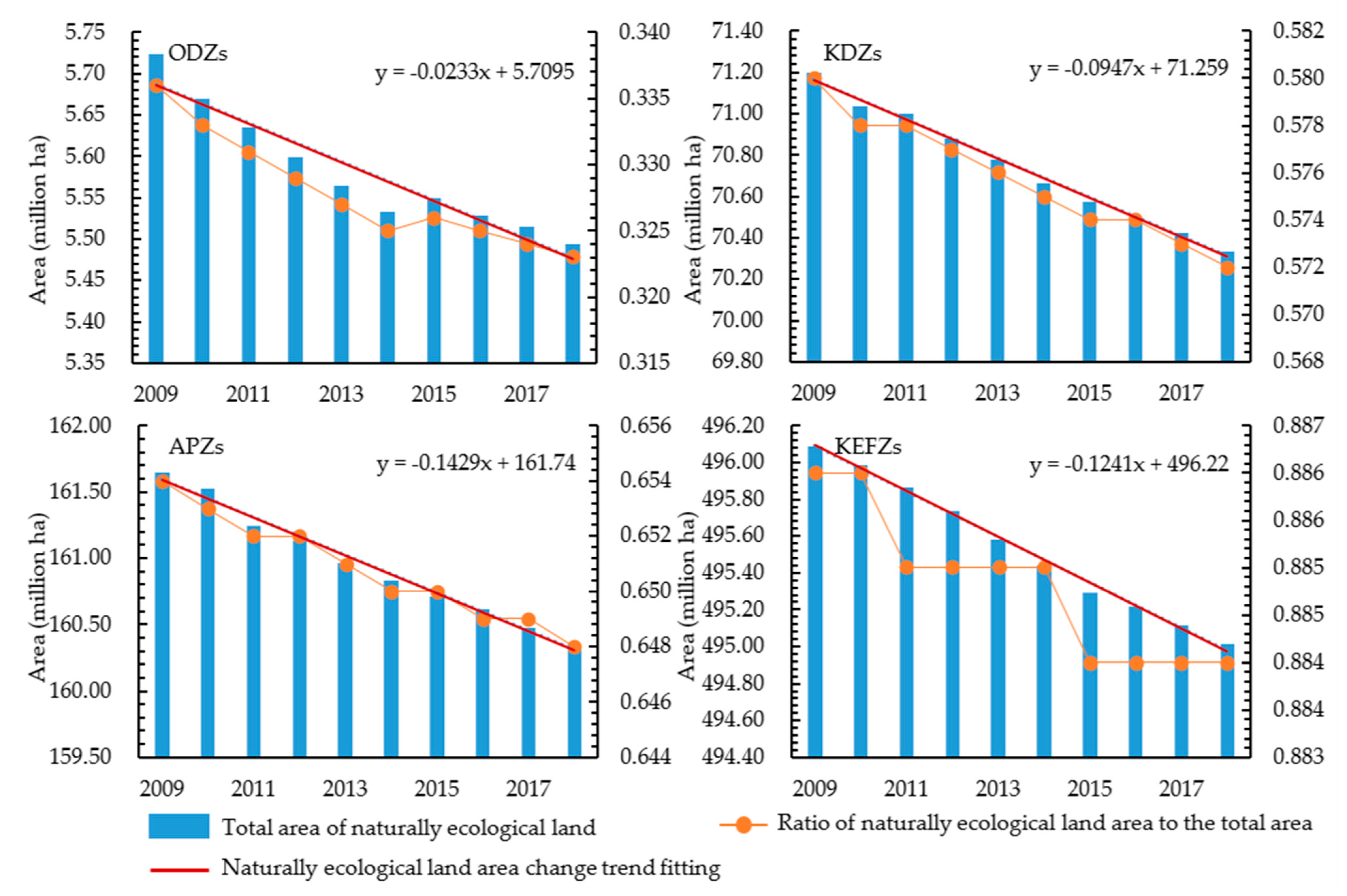Evaluating Natural Ecological Land Change in Function-Oriented Planning Regions Using the National Land Use Survey Data from 2009 to 2018 in China
Abstract
:1. Introduction
2. Materials and Methods
2.1. Study Area and Data
2.2. Method
2.2.1. Integrating Data
2.2.2. Change Indexes of Ecological Land
3. Results
3.1. Spatiotemporal Characteristics of Ecological Land in MFOZ
3.2. Changing of Ecological Land types
3.3. Conversion Between Ecological Land and Non-Ecological Land
4. Discussion
5. Conclusions
Author Contributions
Funding
Institutional Review Board Statement
Informed Consent Statement
Data Availability Statement
Acknowledgments
Conflicts of Interest
References
- Li, D.; Xu, E.; Zhang, H. Influence of ecological land change on wind erosion prevention service in arid area of northwest China from 1990 to 2015. Ecol. Indic. 2020, 117, 106686. [Google Scholar] [CrossRef]
- Guo, X.; Chang, Q.; Liu, X.; Bao, H.; Zhang, Y.; Tu, X.; Zhu, C.; Lv, C.; Zhang, Y. Multi-dimensional eco-land classification and management for implementing the ecological redline policy in China. Land Use Policy 2018, 74, 15–31. [Google Scholar] [CrossRef]
- Yu, F.; Li, X.; Zhang, L.; Xu, W.; Fu, R.; Wang, H. Study of Ecological Land in China: Conception, Classification, and Spatial-temporal Pattern. Acta Ecol. Sin. 2015, 35, 4931–4943. [Google Scholar] [CrossRef] [Green Version]
- Chen, Y.; Zhang, Z.; Guo, X.; Lv, C.; Wang, X. Spatial-temporal Analysis on Ecological Land Changes in the Key Ecological Functional Areas in China. China Land Sci. 2015, 32, 19–26. [Google Scholar] [CrossRef]
- Wang, J.; He, T.; Lin, Y. Changes in ecological, agricultural, and urban land space in 1984–2012 in China: Land policies and regional social-economical drivers. Habitat Int. 2018, 71, 1–13. [Google Scholar] [CrossRef]
- Kopmann, A.; Rehdanz, K. A human well-being approach for assessing the value of natural land areas. Ecol. Econ. 2013, 93, 20–33. [Google Scholar] [CrossRef]
- Chiarenza, G.M. A blueprint for a methodology to balance land-use in semi-natural areas. J. Environ. Plan. Manag. 2020, 63, 2246–2264. [Google Scholar] [CrossRef]
- Yan, H.; Liu, F.; Liu, J.; Xiao, X.; Qin, Y. Status of land use intensity in China and its impacts on land carrying capacity. J. Geogr. Sci. 2017, 27. [Google Scholar] [CrossRef] [Green Version]
- Wu, K.-Y.; Ye, X.-Y.; Qi, Z.-F.; Zhang, H. Impacts of land use/land cover change and socioeconomic development on regional ecosystem services: The case of fast-growing Hangzhou metropolitan area, China. Cities 2013, 31, 276–284. [Google Scholar] [CrossRef]
- Kenneweg, W.H. Landscape response functions for biodiversity—Assessing the impact of land-use changes at the county level. Landsc. Urban Plan. 2004, 67, 157–172. [Google Scholar] [CrossRef]
- Quintas-Soriano, C.; Castro, A.J.; Castro, H.; García-Llorente, M. Impacts of land use change on ecosystem services and implications for human well-being in Spanish drylands. Land Use Policy 2016, 54, 534–548. [Google Scholar] [CrossRef]
- Chuai, X.; Huang, X.; Wu, C.; Li, J.; Lu, Q.; Qi, X.; Zhang, M.; Zuo, T.; Lu, J. Land use and ecosystems services value changes and ecological land management in coastal Jiangsu, China. Habitat Int. 2016, 57, 164–174. [Google Scholar] [CrossRef]
- Bai, Y.; Jiang, B.; Wang, M.; Li, H.; Alatalo, J.M.; Huang, S.F. New ecological redline policy (ERP) to secure ecosystem services in China. Land Use Policy 2016, 55, 348–351. [Google Scholar] [CrossRef] [Green Version]
- Hu, Y.; Zhen, L.; Zhuang, D. Assessment of Land-Use and Land-Cover Change in Guangxi, China. Sci. Rep. 2019, 9, 2189. [Google Scholar] [CrossRef] [PubMed] [Green Version]
- Zhang, Y.; Chang, Q.; Guo, X. Management-oriented ecological land’s conception and multi-dimensional classification system in China. Acta Ecol. Sin. 2016, 36, 3655–3665. [Google Scholar] [CrossRef]
- Sims, R.A.; Corns, I.G.W.; Klinka, K. Introduction-Global to local: Ecological land classification. Environ. Monitor. Assess 1996, 39, 1–10. [Google Scholar] [CrossRef] [PubMed]
- Bunce, R.G.H.; Barr, C.J.; Gillespie, M.K.; Howard, D.C. The ITE land classification: Providing an environmental stratification of Great Britain. Environ. Monitor. Assess 1996, 39, 39–46. [Google Scholar] [CrossRef]
- Dong, Y.W.; Zhou, W.; Zhou, L.; Zhou, H. Study on ecological protection of urbanization area: A case study of Nanjing, Jiangsu. Urban Res. 1999, 75, 6–8. [Google Scholar]
- Sun, X.; Lei, G.; Hai, R.; Ye, Y.; Li, A.; Mark, S.S.; Connor, J.D.; Wu, J.; Bryan, B.A. China’s progress towards sustainable land development and ecological civilization. Landsc. Ecol. 2018, 33, 1647–1653. [Google Scholar] [CrossRef]
- Zou, L.; Liu, Y.; Yang, J.; Yang, S.; Hu, X. Quantitative identification and spatial analysis of land use ecological-production-living functions in rural areas on China’s southeast coast. Habitat Int. 2020, 100, 102182. [Google Scholar] [CrossRef]
- Shi, G.; Jiang, N.; Yao, L.Q. Land Use and Cover Change during the Rapid Economic Growth Period from 1990 to 2010: A Case Study of Shanghai. Sustainability 2018, 10, 426. [Google Scholar] [CrossRef] [Green Version]
- Gao, C.; Feng, Y.; Tong, X.; Jin, Y.; Gu, C. Modeling urban encroachment on ecological land using cellular automata and cross-entropy optimization rules. Sci. Total Environ. 2020, 744, 140996. [Google Scholar] [CrossRef] [PubMed]
- Li, G.; Jiang, C.; Du, J.; Jia, Y.; Bai, J. Spatial differentiation characteristics of internal ecological land structure in rural settlements and its response to natural and socio-economic conditions in the Central Plains, China. Sci. Total Environ. 2020, 709, 135932. [Google Scholar] [CrossRef] [PubMed]
- Fan, J.; Sun, W.; Yang, Z.S.; Fan, P.; Chen, D. Focusing on the major function-oriented zone: A new spatial planning approach and practice in China and its 12th Five-Year Plan. Asia Pac. Viewp. 2012, 53, 86–96. [Google Scholar] [CrossRef]
- Fan, J.; Li, P.X. The scientific foundation of Major Function Oriented Zoning in China. J. Geogr. Sci. 2009, 19, 515–531. [Google Scholar] [CrossRef]
- Zhang, C.; Su, Y.; Yang, G.; Chen, D.; Yang, R. Spatial-Temporal Characteristics of Cultivated Land Use Efficiency in Major Function-Oriented Zones: A Case Study of Zhejiang Province, China. Land 2020, 9, 114. [Google Scholar] [CrossRef]
- Xia, H.; Zhang, W.; He, L.; Ma, M.; Peng, H.; Li, L.; Ke, Q.; Hang, P.; Wang, X.T. Assessment on China’s urbanization after the implementation of main functional areas planning. J. Environ. Manag. 2020, 264, 110381. [Google Scholar] [CrossRef] [PubMed]
- Tan, M. Uneven growth of urban clusters in megaregions and its policy implications for new urbanization in China. Land Use Policy 2017, 66, 72–79. [Google Scholar] [CrossRef]
- Liu, W.C.; Liu, J.Y.; Kuang, W.H.; Jia, N. Examining the influence of the implementation of Major Function-oriented Zones on built-up area expansion in China. J. Geogr. Sci. 2017, 27, 643–660. [Google Scholar] [CrossRef]
- Fan, J. Draft of major function oriented zoning of China. J. Geogr. Sci. 2015, 70, 186–201. [Google Scholar] [CrossRef]
- Wang, H.; Peng, P.; Kong, X.; Zhang, T.; Yi, G. Vegetation dynamic analysis based on multisource remote sensing data in the east margin of the Qinghai-Tibet Plateau, China. Peerj 2019, 7, e8223. [Google Scholar] [CrossRef] [PubMed] [Green Version]
- Xie, Z.H. China’s historical evolution of environmental protection along with the forty years’ reform and opening-up. Environ. Sci. Ecotechnol. 2020, 1, 100001. [Google Scholar] [CrossRef]
- Liu, Y.; Fang, F.; Li, Y. Key issues of land use in China and implications for policy making. Land Use Policy 2014, 40, 6–12. [Google Scholar] [CrossRef]
- Ning, J.; Liu, J.; Kuang, W.; Xu, X.; Zhang, S.; Yan, C.; Li, R.; Wu, S.; Hu, Y.; Du, G.; et al. Spatiotemporal patterns and characteristics of land-use change in China during 2010–2015. J. Geogr. Sci. 2018, 28, 547–562. [Google Scholar] [CrossRef] [Green Version]









| Ecological Land Class | The 2nd National Land Use Survey Class |
|---|---|
| Forest land | Woodland, Shrubbery land, Sparsely forested woodland |
| Grassland | Natural pasture land, Cultivated pasture land, Other grasslands |
| Wetland | River, Lake, Reservoir, Pond, Beach and tidal flat, Inland mudflat, Glaciers and permanent snow, Swamp and marsh |
| Bare land | Desert, Barren land |
| Zone | Forest Land | Grassland | Wetland | Bare Land | Total | |
|---|---|---|---|---|---|---|
| ODZs | 2009 (million ha) | 2.80 | 0.36 | 2.45 | 0.11 | 5.72 |
| 2018 (million ha) | 2.79 | 0.32 | 2.30 | 0.09 | 5.49 | |
| D-value (million ha) | −0.01 | −0.04 | −0.15 | −0.02 | −0.23 | |
| change rate (%) | −0.37 | −12.46 | −6.19 | −18.80 | −4.00 | |
| KDZs | 2009 (million ha) | 36.89 | 22.93 | 6.82 | 4.57 | 71.20 |
| 2018 (million ha) | 36.55 | 22.66 | 6.65 | 4.48 | 70.33 | |
| D-value (million ha) | −0.34 | −0.27 | −0.17 | −0.09 | −0.87 | |
| change rate (%) | −0.91 | −1.18 | −2.44 | −2.01 | −1.22 | |
| APZs | 2009 (million ha) | 66.09 | 52.26 | 11.70 | 31.59 | 161.65 |
| 2018 (million ha) | 65.59 | 51.80 | 11.49 | 31.48 | 160.35 | |
| D-value (million ha) | −0.50 | −0.46 | −0.21 | −0.11 | −1.30 | |
| change rate (%) | −0.76 | −0.89 | −1.83 | −0.36 | −0.80 | |
| KEFZs | 2009 (million ha) | 148.18 | 211.78 | 20.20 | 115.93 | 496.09 |
| 2018 (million ha) | 147.76 | 211.26 | 20.17 | 115.83 | 495.02 | |
| D-value (million ha) | −0.42 | −0.52 | −0.03 | −0.10 | −1.07 | |
| change rate (%) | −0.28 | −0.24 | −0.13 | −0.09 | −0.22 | |
| Major Function Oriented Zones | Forest Land (ha) | Grassland (ha) | Wetland (ha) | Bare Land (ha) | Total (ha) | |
|---|---|---|---|---|---|---|
| ODZs | Increase | 17,389.86 | 4861.53 | 20,151.65 | 2630.48 | 45,033.52 |
| Decrease | 74,390.65 | 53,532.73 | 183,126.31 | 25,733.84 | 336,783.53 | |
| KDZs | Increase | 60,452.20 | 68,807.47 | 50,929.21 | 13,387.30 | 193,576.18 |
| Decrease | 467,412.48 | 381,144.06 | 263,469.34 | 102,387.66 | 1,214,413.54 | |
| APZs | Increase | 46,090.97 | 69,150.17 | 56,517.75 | 23,799.21 | 195,558.10 |
| Decrease | 483,568.78 | 443,179.01 | 243,423.98 | 137,306.77 | 1,307,478.54 | |
| KEFZs | Increase | 75,413.99 | 112,414.57 | 57,184.07 | 23,499.71 | 268,512.34 |
| Decrease | 445,736.49 | 654,134.89 | 104,114.78 | 138,991.28 | 1,342,977.44 | |
Publisher’s Note: MDPI stays neutral with regard to jurisdictional claims in published maps and institutional affiliations. |
© 2021 by the authors. Licensee MDPI, Basel, Switzerland. This article is an open access article distributed under the terms and conditions of the Creative Commons Attribution (CC BY) license (http://creativecommons.org/licenses/by/4.0/).
Share and Cite
Zhang, Z.; Zhang, Y.; Yu, X.; Lei, L.; Chen, Y.; Guo, X. Evaluating Natural Ecological Land Change in Function-Oriented Planning Regions Using the National Land Use Survey Data from 2009 to 2018 in China. ISPRS Int. J. Geo-Inf. 2021, 10, 172. https://0-doi-org.brum.beds.ac.uk/10.3390/ijgi10030172
Zhang Z, Zhang Y, Yu X, Lei L, Chen Y, Guo X. Evaluating Natural Ecological Land Change in Function-Oriented Planning Regions Using the National Land Use Survey Data from 2009 to 2018 in China. ISPRS International Journal of Geo-Information. 2021; 10(3):172. https://0-doi-org.brum.beds.ac.uk/10.3390/ijgi10030172
Chicago/Turabian StyleZhang, Zhijie, Yuanjie Zhang, Xiao Yu, Liping Lei, Yuqi Chen, and Xudong Guo. 2021. "Evaluating Natural Ecological Land Change in Function-Oriented Planning Regions Using the National Land Use Survey Data from 2009 to 2018 in China" ISPRS International Journal of Geo-Information 10, no. 3: 172. https://0-doi-org.brum.beds.ac.uk/10.3390/ijgi10030172






